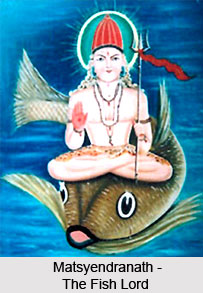 Nath Siddha Matsyendranath or the "Fish Lord" is the first Guru of the nine Naths. Along with Gorakhnath, Matsyendranath is regarded as the founder of the Nath, Kaula and Kanphata traditions. He initiated the practices of Laya, Hatha and Raja Yogas.
Nath Siddha Matsyendranath or the "Fish Lord" is the first Guru of the nine Naths. Along with Gorakhnath, Matsyendranath is regarded as the founder of the Nath, Kaula and Kanphata traditions. He initiated the practices of Laya, Hatha and Raja Yogas.
According to legend, Nath Siddha Matsyendranath was a fisherman from Kamarupa in Assam who hooked a giant fish and was swallowed alive by it. The fish came to rest on the ocean floor near a hidden place, which Shiva had chosen to convey his most secret teaching to his consort Uma.
From within the belly of the fish Nath Siddha Matsyendranath overheard these secret teachings and received his mantra directly from Shiva, who had no option but to make Matsyendranath his disciple. Nath Siddha Matsyendranath spent twelve years perfecting his sadhana living in the belly of the fish until he was eventually disgorged onto dry land. He had many disciples, the most prominent of which was Gorakhnath.
In Nepal, Nath Siddha Matsyendranath is identified with the Buddhist bodhisattva of compassion, Avalokitesvara, who is identified with Shiva as Lokanath-"Lord of the World." Nath Siddha Matsyendranath is the patron deity of Nepal, and is believed to have brought the first grains of rice to this Himalayan Kingdom.
This article is a stub. You can enrich by adding more information to it. Send your Write Up to content@indianetzone.com




















